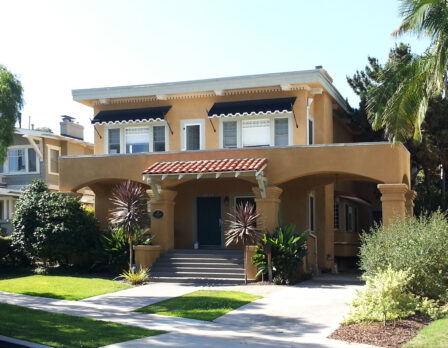The Prarie Style Homes of Mission Hills to be Showcased
Mission Hills Heritage’s Eleventh Annual Historic Home Tour
The Mission Hills neighborhood of San Diego features a rich variety of early 20th century architectural styles. This year, Mission Hills Heritage (MHH) is showcasing Prairie Style homes built in the 1910s and 1920s on its Eleventh Annual Historic Home Tour, Friday, September 26. Six lovely homes will be open for tour attendees to view the wonderful exterior and interior details of the residences. As an additional feature on the tour, there will be a showing of the 1920’s historic United Church of Christ at 400 Jackdaw, a highly substantial landmark in Mission Hills.

This stately home is an example of one of the residences that have continued to grace the Mission Hills neighborhood for more than a century. (Photo by Hugh Largey.)
The Prairie Style was developed by a group of Chicago architects who have become known as the “Prairie School.” Considered a radical design from the perspective of Victorian America, features of the Prairie Style include a low-pitched, usually hipped roof, widely overhanging eaves with one-story wings or porches, cornices and facade detailing emphasizing horizontal lines, wide bands of windows and often massive, square porch supports.
Frank Lloyd Wright’s early work was in the Prairie Style and he was acknowledged as a master designer of the Prairie house. Many of the other Prairie architects worked with either Frank Lloyd Wright himself, or with his earlier employer and teacher, Louis Sullivan.
How did the Prairie Style migrate to San Diego and Mission Hills? It originated in Chicago and the landmark examples are concentrated in that city’s early 20th century suburbs and other large Midwestern cities. However, vernacular examples were spread widely in pattern books and popular magazines such as Western Architect.
Seeking a new life in the west, numerous architects, builders and individuals traveled from the east and arrived in San Diego introducing fresh and new home designs.
Irving Gill, a prominent San Diego architect, worked under Louis Sullivan and Frank Lloyd Wright in Chicago. Gill built several Prairie Style homes and buildings in San Diego and the style also influenced his later designs. The Prairie Style also caught on with many local San Diego builders working in Mission Hills, including Nathan Rigdon, Martin Melhorn, Alexander Schreiber and Morris B. Irvin. Local adaptations included hybrids combining elements of Craftsman, Mission, and even Mediterranean Revival Styles. Our milder climate provided designs for open balconies and porches instead of the enclosed porches of Chicago and pergolas and porte-cocheres with climbing wisteria, instead of the built-in planter boxes seen in the Midwest. The Spanish Revival Style replaced the Arts & Crafts and Prairie Styles in the 1920s; however, the Prairie Style greatly influenced later California styles such as Mid-Century Modern and Ranch.
Come and experience how San Diego architects and builders applied the Prairie Style in San Diego at Mission Hills Heritage’s Eleventh Annual Historic Home Tour.
Advance or mail-in purchase: $20 MHH members; $25 non-members. Advance reservations may be mailed in by September 19 to: Mission Hills Heritage, 325 W. Washington Street, Suite 2, Box 221, San Diego, CA 92103, or online by September 25 at: https://www.brownpapertickets.com/event/2156710.
Day of Tour Purchase: $25 MHH Members • $30 Non-Members (Checks or Cash only please). Ticket sales begin at 10 a.m. Ticket sales location at United Church of Christ, 4070 Jackdaw Street, San Diego, CA 92103.
For more information about Mission Hills Heritage, visit: www.MissionHillsHeritage.org or email: info@MissionHillsHeritage.org or call (619) 497-1193
Category: Events, Local News







